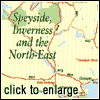|
Inverness

The approach to Inverness on the A9 is quite dramatic,
coming down a long decline above the town and heading for the Kessock Bridge. To
best appreciate it, pull into the Visitor Information Centre on the west side of
the dual carriageway where there is an outlook point.
Inverness is the social, cultural, transport and administration
centre for the Highlands, serving a huge area that includes the Western Islands as
well as communities to the north and east. The first written references to the town
came in the sixth century with Adamnan's account of the life of St Columba. He describes,
therein, the saint's visit to King Brude's fortress on his mission to convert the
northern Picts to his religion.
Inver means 'mouth', with the town being established
near the mouth of the River Ness where it meets the Beauly Firth. There are lovely
views looking from the lower bridges up to the town and its red-sandstone castle
perched on the southern banks.
The original Inverness Castle was the possible scene
of the murder of King Duncan by Macbeth and stood in the Crown area to the east of
the present Castle Hill. The present castle, built between 1834 and 1846, contains
the offices of local government and law courts.
Just below the castle is the Tourist Information Office
in Upper Bridge Street, adjacent to the town's museum, which contains various items
relating to the town's and Highland history as well as an art gallery.
Most of Inverness's High Street has been pedestrianised
so it is easy to amble through an area mostly given over to High Street retail shops.
There is little of architectural interest. For indoor-shopping there is the modern
Eastgate Centre and various supermarkets if you wish to stock up on reasonably priced
groceries before venturing further north or west.
Inverness caters well to the archetypal tourist who
wishes to trace and identify with their Scottish ancestors. At the local library
in Farraline Park, beside the bus station, there is a genealogist-in-residence through
the summer months. He offers an initial, free consultation to those that wish to
discover their Highland roots.
The Clan Tartan Centre at Holm Mills can also work
out which tartan you are entitled to wear and for a small fee include this and your
clan history on a certificate. After this you should feel thoroughly Scotified.
Following Church Street, you come to Abertarff House,
one of the oldest buildings in Inverness dating from 1592 and containing a wonderful
turnpike stairway. It also serves as the Highland regional headquarters for the National
Trust for Scotland.
Crossing the river by the Ness Bridge and turning
left along the river on Ness Walk, you come to Eden Court, the most northerly theatre
in the UK, built in 1976 and named after the Bishop Robert Eden who commissioned
the adjacent cathedral a century before. The main hall has 800 seats and the building
has a variety of uses as a theatre, conference centre and art gallery. There is a
small restaurant. Nearby St Andrew's Cathedral, built in 1866 to 1869, has an elaborate
interior with a choir screen and rood cross by Robert Lorimer, well worth seeing.
The font is a copy of Thorwalden's Font in Copenhagen Cathedral.
For a pleasant walk you can follow the banks of the
river on either side or cross the Georgian bridges to Ness Islands which have been
turned into attractive public parks.
The Caledonian Canal
Also worth seeing is the northern end of Telford's
Caledonian Canal. Here the Brahan Seer, a sixteenth or seventeenth century Highland
prophet, predicted the coming of the canal, allowing ships to sail across Scotland.
'Strange as it may seem to you this day, a time will
come when full-rigged ships will be seen sailing eastward and westward by the back
of Tomnahurich near Inverness'.
Tomnahurich is the noticeable lump, otherwise know
as the 'Fairy Hill' near to the canal. The Brahan Seer touched on many other facets
of Highland life that have since come true. 'That the clans will become so effeminate
as to flee from their native country before an army of sheep' was another poignant
premonition.
A popular excursion from Inverness is down the A82
to Loch Ness as far as Drumnadrochit and Castle Urquart. There is only a small stretch
of the man-made canal at this end of the loch where it runs parallel with the River
Ness.
The Caledonian Canal stretches from the Beauly Firth
in the north to Loch Eil in the south linking Loch Lochy, Loch Oich, Loch Ness and
the small Loch Dochfour. Less than half of its 60 miles (97km) are man-made. The
rest is a massive geological fault called the Great Glen which runs diagonally across
Scotland, already half full of water when Thomas Telford commenced the canal in 1803.
One of the reasons the government employed Telford to institute his plans was to
give employment to the hundreds of Highlanders who had poured into the area following
the Highland Clearances.
The canal was never the industrial success that was
hoped for and has since been used mainly for fishing boats or pleasure craft traversing
the Highland interior. But the feat of digging this gigantic trench through some
of Scotland's most inhospitable countryside still stands as a monument to the men
who made it.
Loch Ness
Loch Ness is a spectacular stretch of water although
the A82 alongside can be quite busy. The natural Highland vegetation that lines its
banks, birch, alder, rowan and hazel trees, now struggle to resist the intense forestry
schemes of pine that continue to engulf wide swathes of the Highlands. It was the
construction of this road in the 1930s that sparked off the modern craze for monster
spotting when workmen and locals claimed many sightings. Perhaps the digging and
blasting disturbed the monster. The first mention of 'Nessie', as he or she is colloquially
known, goes back to St Adamnan's chronicle of St Colomba who had to placate the monster
following its attack on a fellow monk.
 For the chance of a closer encounter with the monster, the
best bet might be to go underwater. Operating from the Clansman Marina about 6 miles
(l0km) south of Inverness is the Swatch Loch Ness Submarine where a small submersible
dives several times a day to the floor of the loch usually at around 400ft (122m). For the chance of a closer encounter with the monster, the
best bet might be to go underwater. Operating from the Clansman Marina about 6 miles
(l0km) south of Inverness is the Swatch Loch Ness Submarine where a small submersible
dives several times a day to the floor of the loch usually at around 400ft (122m).
As it is primarily a scientific project, various daily
missions are set to observe things like plankton, fish or sediment. Samples of the
sediment taken by the submarine show changes in the atmosphere over the past 10,000
years and incidents such as Chernobyl and the accumulated debris from the Industrial
Revolution. Visibility is good at lower levels although, because of the peat stain
in the water, it is a bit like diving through a glass of whisky. Places in the submarine
are limited so advance reservations are nearly always necessary. Contact the local
tourist information centre for details (Tel 01456 450709).
At Drumnadrochit, a third of the way down the loch,
the Loch Ness experience congeals into a mass of commercial monster madness. The
best chance visitors may have of seeing the elusive Nessie is by standing next to
the model in the pond at the 'The Official Loch Ness Monster Exhibition Centre'.
Using sight and sound in a multi-media presentation, the centre offers facts about
the monster and leaves you to draw your own conclusion. There are shops and craft
outlets as well as a restaurant, lounge bar, coffee shop and hotel at Drumnadrochit.
Visitors driving to Urquart Castle, 2 miles (3km)
further along the A82, reserve a portion of their attention to the choppy waters
of the loch, hoping for a chance sighting and a fortune-making photograph. It is
around this area that most of the sightings have been made.
Urquhart Castle was once one of the largest castles
in Scotland and it stands on a rocky outcrop that juts out into the loch, part of
a series of forts that controlled the Great Glen. Since Pictish times the site has
been strategic. It was partly dismantled by the English during the Jacobite rebellion
to avoid it becoming a rebel outpost and through the centuries since, its decay has
continued. The castle is reached by crossing the defensive ditch and entering the
crumbled stone walls through a series of arches and tunnels before reaching the outer
loch-side walls and tower. The cavern where Ted Danson finally meets the monster
in 'Loch Ness', the movie, unfortunately does not exist - as far as I know!
The A82 continues through Invermoriston where you
can take a diversion through Glen Moriston to see the memorial for Roderick McKenzie,
a follower and look-alike of Bonnie Prince Charlie. He was captured and killed by
the Redcoats but before he died he bravely cried 'You have killed your prince' thus
delaying the pursuit of the true monarch.
 Fort Augustus is a crossing point of the Caledonian Canal
and the main A82. Here, sailors and their craft often gather at the quaysides and
adjourn to the bars, waiting to pass through the locks the next morning. Following
the 1715 Jacobite uprising, a garrison was established in the town to quell further
trouble. Fort Augustus is a crossing point of the Caledonian Canal
and the main A82. Here, sailors and their craft often gather at the quaysides and
adjourn to the bars, waiting to pass through the locks the next morning. Following
the 1715 Jacobite uprising, a garrison was established in the town to quell further
trouble.
A fort was built named after George II's son, William
Augustus, Duke of Cumberland, later to become known throughout the Highlands as 'Butcher
Cumberland' following his victory at Culloden and the subsequent atrocities carried
out on the vanquished Highlanders. The fort was dismantled and incorporated into
an abbey, now a public school with its church open to visitors.
A golf course is found on the edge of town, moved
there in 1925 to make way for tree planting. The proviso was that the course would
have to share the ground with sheep, which remains so today.
It is possible to return to Inverness via the south
road of Loch Ness but, although very scenic, it is twisting and hilly so allow of
plenty time. The plunging Falls of Foyers are 10 miles (16km) north of Fort Augustus
on this route, the B862, and quite spectacular.
The estates of Coignafearn, in the heart of the Monadhliath
Mountains, can be reached from the B851 where a variety of deer, red kites, wild
goats and the occasional Golden Eagle can often be seen. Bare in mind, it is a demanding
drive through forest and mountainous single track road to this remote glen that surrounds
the River Findhorn. It can also be reached via Tomatin on the A9 about 16 miles (26km)
south of Inverness.
|



